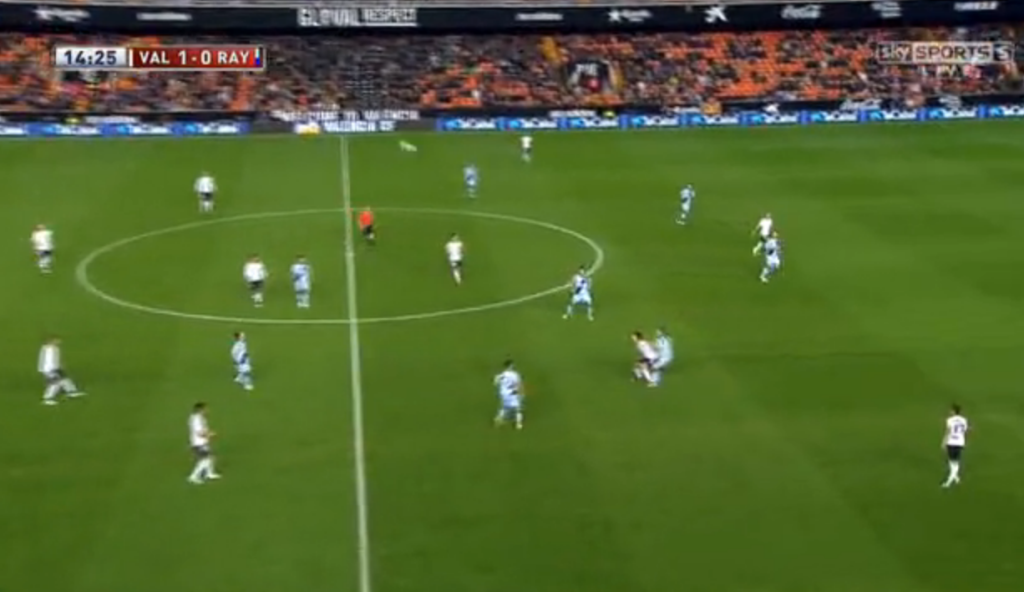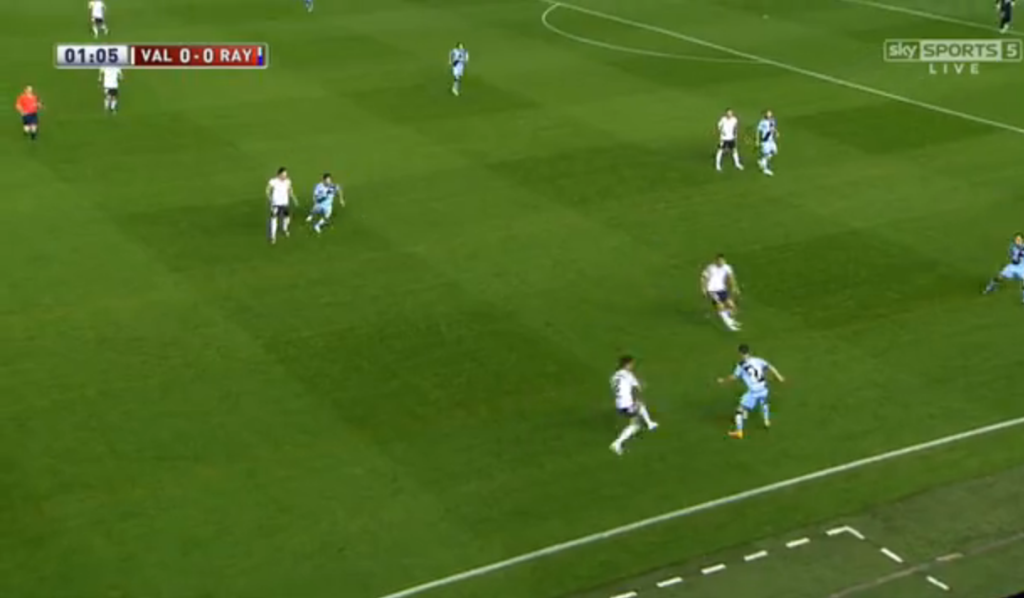Valencia – Rayo Vallecano 4:4
This was an incredible high scoring game that fit both the occasion of the Copa Del Rey Round of 16, and these two great Spanish teams. Various strategical and tactical changes occurred in the match, but the high intensity and pressure always remained throughout. Though Rayo put on a brave display, it was ultimately Valencia’s changes coupled with their quality that tilted this tie in their favor.
High Pressure Play
Both teams in this matchup focused highly on constant and aggressive pressure on the ball. This is ultimately what gave the game it’s open and exciting rhythm. In the first half, Rayo was playing in a 3-4-1-2 formation while Valencia played in a 4-3-3.
Valencia’s fullbacks pushed very high up the field while the wingers moved inside to form a more narrow front line. They used their fullbacks in tandem with their forwards in tight combinations in order to break through the high pressure of Rayo. Cancelo in particular was very impressive with his abilities in combination play and dribbling. Another aspect of Valencia’s attack was their pace in all positions. They were able to expose open spaces in Rayo’s defense very quickly.
The high defensive pressure from both teams was more in a man-oriented fashion rather than pressuring the local area in regards to the ball’s position. This meant that if a player was able to beat his marker it would be even more dangerous for the remainder of the attack in creating overloads. As opposed to having many players in near-by zones to congest any possible situations that could occur. Pressing very high is not the most stable approach in itself as the defending team will always have at least 1 player less, because the goalkeeper acts as an extra man in possession (if used correctly). So the stakes and rewards were very high in this match, as can be seen in the scoreline.
Rayo displayed their bravery and willingness to stick to their Positional Play philosophy under Paco Jemez. Though in a few scenes they weren’t technically adept enough in crucial moments of the build-up to break through Valencia’s press, which led to some dangerous chances for the home team.
In terms of positional structure, Rayo did well. Because of their good positional structure they were able to counter pressl and create dangerous chances in transition. For most of the game their best chances resulted from situations where they won the ball from counterpressing rather than building the play through Valencia’s defensive lines. For example, Rayo struggled to escape zones where Valencia isolated them, like the flanks. Though when the ball was lost and Rayo immediately recovered it, they were able to play the ball away from pressure into the open spaces due to Valencia being disorganized after the ball is lost.
Valencia are particularly talented at isolating their opponents and pressing the ball as a collective in these isolated areas. Their more forward players worked hard to backwards-press and close pressing traps that were triggered when Rayo tried to play in between Valencia’s lines. Vertical balls into the forwards (which became more frequent near the end of the half due to a drop in Valencia’s intensity) were pressed nicely. Alex Moreno was a Rayo player who displayed his talents in these types of situations. He was pressure resistant, and he even had some great 1 vs. 1 battles against Cancelo.
Rayo displayed their ability to quickly close down on the ball when it was played in between their lines as well. Both teams put on a good display of what was intense and high-pressure Spanish football. Though near the half both teams started to drop off in intensity as expected, and Rayo had more success in these phases of the game. Particularly because of the differences in systems for the first half, Rayo had many offensive players high up the field. So when Vallecano’s goalkeeper would start kicking long balls Rayo was better prepared to win the ball or press the second ball.
2nd Half Changes
Valencia switched to a 3-4-1-2 for the second half. Up top they had Alacer and Negredo. Just behind them in the creator role was Rodrigo (#20), who is a talented dribbler. The wingbacks were Piatti and Rodrigo (#17), the central midfielders were Parejo and Gomes. The back 3 consisted of Vezo, Mustafi, and Orban.
This change of system had interesting effects. In regards to Rayo’s offense, Jemez’s men were now able to find space out wide in behind the very high wingbacks of Valencia. From these areas where Valencia lacked adequate defensive access, Rayo was able to create the most dangerous situations in the second half – including their 4th goal.
Valencia’s success in the 2nd half stemmed from their risky but well-performed system. They had a very wide-fanning back 3 who liked to join the attack and play incisive passes. The 3 in the back provided some extra stability against Rayo’s 2 forwards, while players like Rodrigo (#20), Piatti, and Rodrigo (#17) were playing just ahead of them ready to use their combinative talents and dribbling abilities to create dangerous chances.
This meant that Valencia play far less long balls and play far more short and controlled passes in their buildup. Coupled with this was the dribbling ability of their key players in offense to break through highly pressurized areas by Rayo Vallecano, and expose areas which were left open. Though there was some questionable officiating in this game, both teams played well enough to deserve their goals.
Conclusion
The 4:4 result ended up being enough for Valencia because they had a 1:2 away win at Rayo Vallecano. Rayo Vallecano put in a very valiant effort, and deserve praise for their bravery. Paco Jemez is an outstanding coach and I’m sure many people would love to see him at a bigger club. Now Valencia move onto the quarterfinals of the Copa Del Rey. They join an impressive list of clubs in the quarterfinals, including: Atletico Madrid, Real Madrid, Bilbao, Barcelona, Villarreal, Sociedad, and Sevilla. It promises to be a tournament that will provide even more excitement in the future.






1 Kommentar Alle anzeigen
blub January 6, 2015 um 1:22 pm
what a game.
liked it.
reading that was totally worth it.